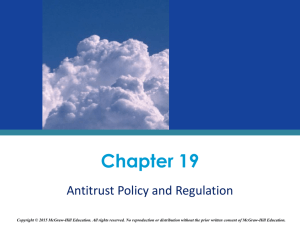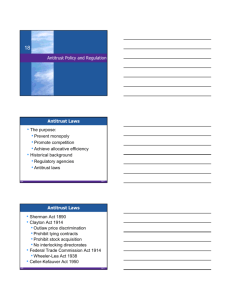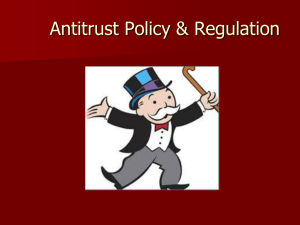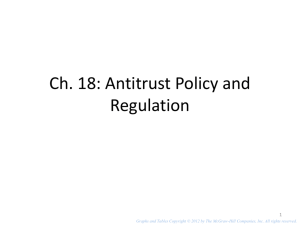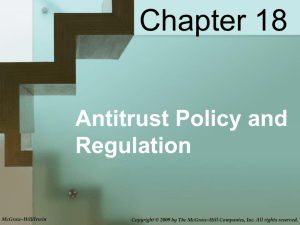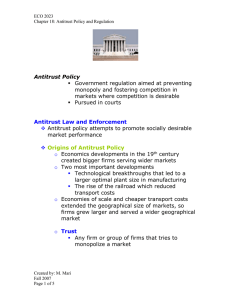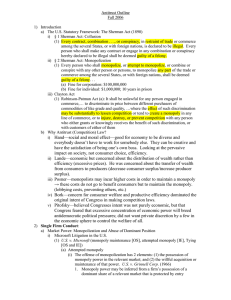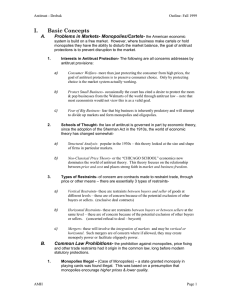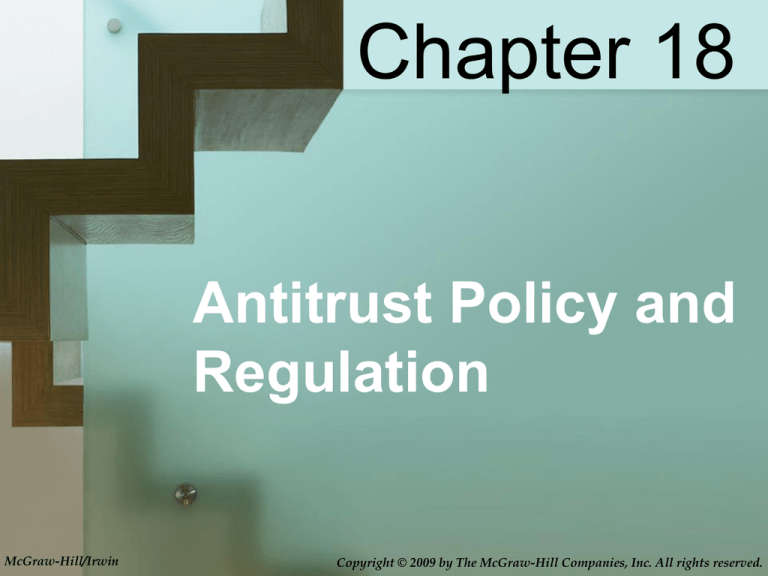
Chapter 18
Antitrust Policy and
Regulation
McGraw-Hill/Irwin
Copyright © 2009 by The McGraw-Hill Companies, Inc. All rights reserved.
Chapter Objectives
• Antitrust laws in the United
States
• Interpretation and application
of antitrust laws
• Natural monopolies
• Social regulation
18-2
Antitrust Laws
• The purpose:
–Prevent monopoly
–Promote competition
–Achieve allocative efficiency
• Historical background
–Regulatory agencies
–Antitrust laws
18-3
Antitrust Laws
• Sherman Act 1890
• Clayton Act 1914
– Outlaw price discrimination
– Prohibit tying contracts
– No interlocking directorates
• Federal Trade Commission Act 1914
• Wheeler-Lea Act 1938
• Celler-Kefauver Act 1950
18-4
Antitrust Policy
• Issues of interpretation
• Monopoly behavior or structure
–1911 Standard Oil Case
–1920 U.S. Steel Case
–1945 Alcoa Case
• The relevant market
–1956 DuPont Cellophane Case
• Issues of enforcement
18-5
Effectiveness of Antitrust Laws
• Monopoly
–Microsoft Case
• Mergers
–Horizontal merger
–Vertical merger
–Conglomerate merger
18-6
Types of Mergers
Automobiles
Blue Jeans
Conglomerate Merger
Blue
Jeans
Autos
A
T
B
U
C
V
Glass
Horizontal Merger
D
E
F
W X Y Z
Denim
Fabric
Vertical Merger
18-7
Effectiveness of Antitrust Laws
• Merger guidelines
–The Herfindahl Index
• Price fixing
• Price discrimination
• Tying contracts
18-8
Natural Monopoly
• Economies of scale
• Public utilities
–Electricity, water, gas, phone
• Solutions for better outcomes
–Public ownership
–Public regulation
–Public interest theory of regulation
18-9
Industrial Regulation
• Regulators establish rates to give
natural monopoly “fair return”
• No incentive to reduce cost
• X-inefficiency
• Perpetuate monopoly
–Conditions of natural monopoly can
end
18-10
Social Regulation
• Applies “across the board” to all
industries
• Food and Drug Administration 1906
• Equal Employment Opportunity
Commission 1964
• Occupational Safety and Health
Administration 1971
• Environmental Protection Agency 1972
• Consumer Product Safety Commission
1972
18-11
Social Regulation
•
•
•
•
Optimal level of social regulation
In support of social regulation
Criticisms of social regulation
Two reminders
–There is no free lunch
–Less government is not always
better than more
18-12
United States vs. Microsoft
• Charged May 1998 under the
Sherman Act
• Accused of having a “Windows”
monopoly
• District court findings:
– Used anticompetitive means
• District court remedy
• Appeals court ruling
• Final settlement
18-13
Key Terms
• antitrust policy
• U.S. Steel case
• industrial regulation
• rule of reason
• social regulation
• Alcoa case
• Sherman Act
• DuPont cellophane case
• Clayton Act
• Microsoft case
• tying contracts
• horizontal merger
• interlocking directorates
• vertical merger
• Federal Trade Commission
Act
• conglomerate merger
• cease-and-desist order
• natural monopoly
• Wheeler-Lea Act
• public interest theory of
regulation
• Celler-Kefauver Act
• Standard Oil case
• per se violations
• legal cartel theory of
regulation
18-14
Next Chapter Preview…
Agriculture:
Economics and
Policy
18-15


